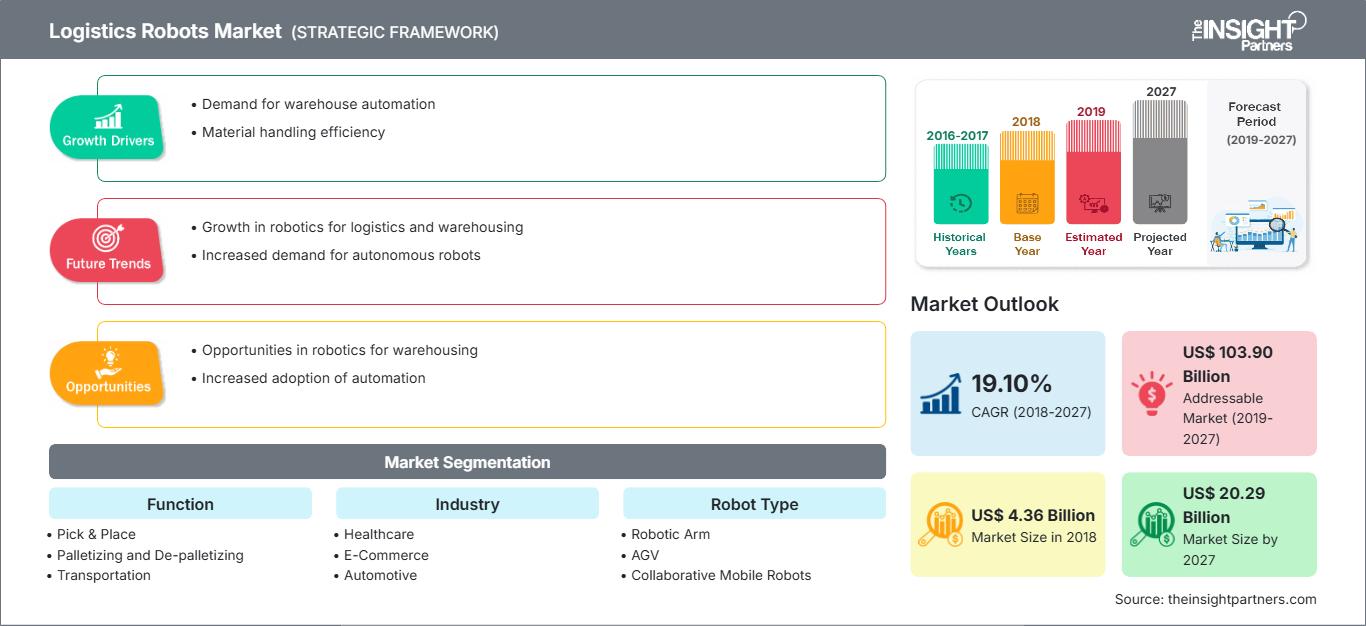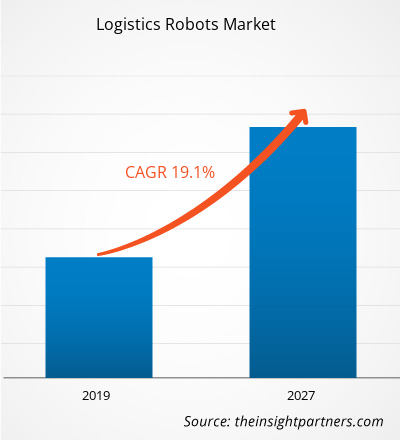Le marché des robots logistiques était évalué à 4 356,2 millions de dollars américains en 2018 et devrait croître à un TCAC de 19,10 % de 2019 à 2027 pour atteindre 20 293,4 millions de dollars américains d'ici 2027.
Le nombre d'entreprises de logistique et d'entreposage qui se concentrent fortement sur l'intégration de robots pour bénéficier d'une efficacité, d'une rapidité et d'une rentabilité accrues afin de rester compétitives sur un marché est en augmentation. L'adoption de technologies de pointe telles que les technologies robotisées d'entreposage et de logistique se développe afin d'améliorer l'efficacité opérationnelle à un prix abordable. Le marché mondial des robots logistiques est stimulé par des facteurs tels que le pourcentage croissant de la population vieillissante à l'échelle mondiale entraînant une pénurie de main-d'œuvre et l'augmentation des réseaux de chaîne d'approvisionnement à l'échelle mondiale. Cependant, les investissements élevés dans le déploiement de robots logistiques devraient freiner la croissance du marché des robots logistiques au cours de la période de prévision. Cependant, l'automatisation croissante des entrepôts et le marché bien établi dans les pays de l'APAC et de l'Europe devraient offrir des opportunités de croissance substantielles pour améliorer les parts de marché des acteurs du secteur dans un avenir proche.
Analyse du marché : Le pourcentage croissant de la population vieillissante à l'échelle mondiale entraîne une pénurie de main-d'œuvre
Le pourcentage croissant de la population vieillissante à l'échelle mondiale est l'un des principaux facteurs de réduction de la main-d'œuvre dans divers secteurs. Chaque pays du monde connaît une augmentation du nombre de personnes âgées dans sa communauté. Le vieillissement de la population est devenu l'un des facteurs importants des transformations sociales du XXIe siècle dans tous les secteurs, y compris le travail et les marchés financiers. Cependant, plusieurs pays comme l'Italie, le Japon et bien d'autres sont ceux qui ont enregistré le plus grand nombre de personnes vieillissantes, en considérant qu'un pourcentage important de leur population a plus de 65 ans. Selon l'OMS, environ 2 millions de personnes dans le monde devraient avoir plus de 60 ans d'ici 2050, soit trois fois plus qu'en 2000. Le vieillissement de la population est à l'origine de la pénurie de main-d'œuvre. L'utilisation de robots logistiques dans plusieurs secteurs joue un rôle important : elle réduit le coût global des processus, augmente la productivité, renforce la sécurité et réduit les erreurs humaines. Les rapides avancées technologiques dans les entrepôts du monde entier se concentrent sur les besoins liés aux difficultés rencontrées par les processus de la chaîne d'approvisionnement et garantissent que la technologie utilisée est adaptée aux objectifs commerciaux. L'utilisation de robots dans différentes unités, fonctions et étapes du cycle de vie des produits est un défi majeur pour les entrepôts dans leur croissance actuelle, ce qui devrait stimuler le marché des robots logistiques dans un avenir proche.
Vous bénéficierez d’une personnalisation sur n’importe quel rapport - gratuitement - y compris des parties de ce rapport, ou une analyse au niveau du pays, un pack de données Excel, ainsi que de profiter d’offres exceptionnelles et de réductions pour les start-ups et les universités
Marché des robots logistiques: Perspectives stratégiques

-
Obtenez les principales tendances clés du marché de ce rapport.Cet échantillon GRATUIT comprendra une analyse de données, allant des tendances du marché aux estimations et prévisions.
Le segment des robots mobiles collaboratifs a conquis la plus grande part du marché mondial des robots logistiques. Déployés dans divers secteurs pour effectuer diverses tâches telles que l'emballage, la surveillance des machines et la manutention, ces cobots sont suffisamment performants pour gérer des opérations lourdes comme légères. Ils sont extrêmement précis, flexibles et précis. De plus, les cobots sont faciles à entretenir et plus faciles à reconfigurer et à reprogrammer. Ces robots peuvent également effectuer des tâches sensibles ; ils s'adaptent également aux incohérences survenant lors des processus de fabrication. Les cobots sont capables de collecter des indicateurs critiques pour fournir des analyses embarquées, ainsi que des rapports, afin de simplifier le processus décisionnel, ce qui stimule le marché global des robots logistiques.
Aperçu des fonctions
Le segment du transport a conquis la plus grande part du marché mondial des robots logistiques. Les marchandises sont palettisées et présentent de légères variations de formes et de tailles, ce qui a nécessité l'automatisation du chargement et du déchargement de ces marchandises. La vision laser 3D est intégrée au nouveau logiciel robotique, ce qui permet aux utilisateurs de visualiser les différents produits dans les conteneurs, de déterminer la séquence idéale de chargement/déchargement et d'exécuter le processus avec une grande précision. La robotique logistique, utilisée pour déplacer les rayonnages cibles, tirer et soulever les paniers, étirer les fourches sur les étagères et les ramener à la position cible, stimule le marché global des robots logistiques.
Informations sur le secteur
Le segment de la logistique externalisée détient la plus grande part du marché mondial des robots logistiques. Ces prestataires de services logistiques proposent divers services, notamment l'entreposage, la gestion des stocks, le transport, la distribution, l'exécution des commandes et la consolidation du fret. La demande croissante de livraisons rapides et de réduction des coûts d'expédition, l'accent mis sur la gestion des stocks, ainsi que la réduction des actifs de l'entreprise, devraient stimuler le marché des robots logistiques au cours de la période de prévision.
Plusieurs stratégies d'initiatives commerciales sont couramment adoptées par les entreprises pour étendre leur présence à l'international et répondre à la demande croissante. Cette stratégie est principalement observée en Europe et en Asie-Pacifique. Les acteurs du marché des robots logistiques adoptent une stratégie d'expansion et d'investissement en recherche et développement pour élargir leur clientèle à l'international, ce qui leur permet également de préserver leur image de marque à l'international.
Aperçu régional du marché des robots logistiques
Les tendances régionales et les facteurs influençant le marché des robots logistiques tout au long de la période de prévision ont été analysés en détail par les analystes de The Insight Partners. Cette section aborde également les segments et la géographie du marché des robots logistiques en Amérique du Nord, en Europe, en Asie-Pacifique, au Moyen-Orient et en Afrique, ainsi qu'en Amérique du Sud et en Amérique centrale.
Portée du rapport sur le marché des robots logistiques
| Attribut de rapport | Détails |
|---|---|
| Taille du marché en 2018 | US$ 4.36 Billion |
| Taille du marché par 2027 | US$ 20.29 Billion |
| TCAC mondial (2018 - 2027) | 19.10% |
| Données historiques | 2016-2017 |
| Période de prévision | 2019-2027 |
| Segments couverts |
By Fonction
|
| Régions et pays couverts |
Amérique du Nord
|
| Leaders du marché et profils d'entreprises clés |
|
Densité des acteurs du marché des robots logistiques : comprendre son impact sur la dynamique des entreprises
Le marché des robots logistiques connaît une croissance rapide, porté par une demande croissante des utilisateurs finaux, due à des facteurs tels que l'évolution des préférences des consommateurs, les avancées technologiques et une meilleure connaissance des avantages du produit. Face à cette demande croissante, les entreprises élargissent leur offre, innovent pour répondre aux besoins des consommateurs et capitalisent sur les nouvelles tendances, ce qui alimente la croissance du marché.

- Obtenez le Marché des robots logistiques Aperçu des principaux acteurs clés
- Analyse historique (2 ans), année de base, prévision (7 ans) avec TCAC
- Analyse PEST et SWOT
- Taille du marché Valeur / Volume - Mondial, Régional, Pays
- Industrie et paysage concurrentiel
- Ensemble de données Excel
Rapports récents
Rapports connexes
Témoignages
Raison d'acheter
- Prise de décision éclairée
- Compréhension de la dynamique du marché
- Analyse concurrentielle
- Connaissances clients
- Prévisions de marché
- Atténuation des risques
- Planification stratégique
- Justification des investissements
- Identification des marchés émergents
- Amélioration des stratégies marketing
- Amélioration de l'efficacité opérationnelle
- Alignement sur les tendances réglementaires






















 Obtenez un échantillon gratuit pour - Marché des robots logistiques
Obtenez un échantillon gratuit pour - Marché des robots logistiques